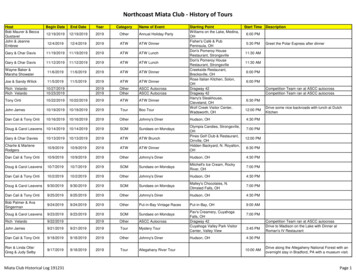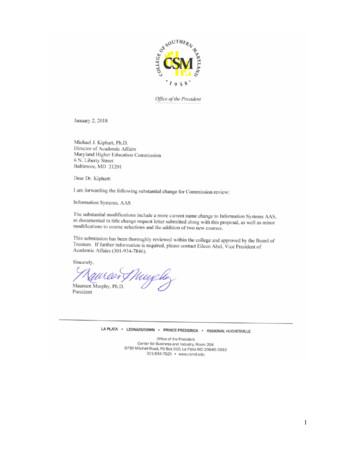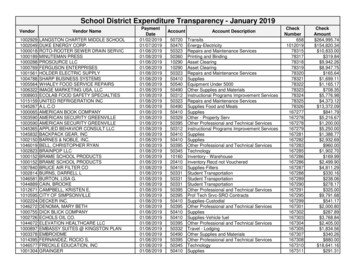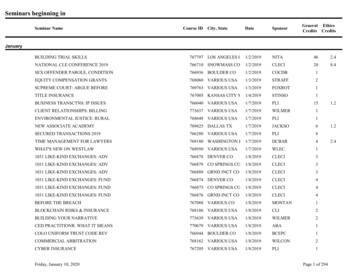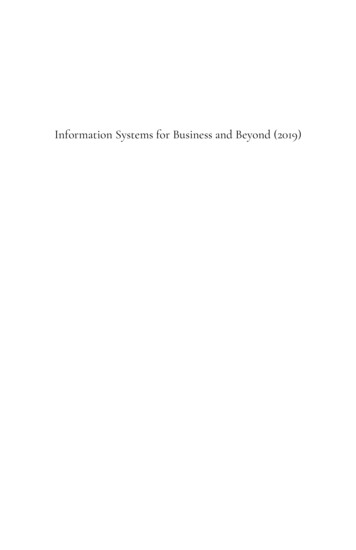
Transcription
Information Systems for Business and Beyond (2019)
Information Systems forBusiness and Beyond (2019)Information systems, their use in business, and thelarger impact they are having on our world.DAVID BOURGEOISJOSEPH MORTATI, SHOUHONG WANG,AND JAMES SMITH
Information Systems for Business and Beyond (2019) by David Bourgeois is licensedunder a Creative Commons Attribution-NonCommercial 4.0 International License,except where otherwise noted.This book was initially developed in 2014 by Dr. David Bourgeois as part ofthe Open Textbook Challenge funded by the Saylor Foundation. This 2019edition is an update to that textbook.This book was produced with Pressbooks (https://pressbooks.com) andrendered with Prince.
Information Systems forBusiness and BeyondUpdated edition: August 1, 2019DAVID T. BOURGEOIS, PH.D.JAMES L. SMITH, PH.D.SHOUHONG WANG, PH.D.JOSEPH MORTATI, MBATitle Page v
CopyrightInformation Systems for Business and Beyond (2019) by David Bourgeois is licensedunder a Creative Commons Attribution-NonCommercial 4.0 International License,except where otherwise noted.vi Copyright
Book ContributorsInformation Systems for Business and Beyond was originallydeveloped in 2014 by David T. Bourgeois Ph.D.Updates for the 2019 edition were graciously contributed by: James L. Smith Ph.D. (all chapters) Shouhong Wong, Ph.D. (chapters 4 and 8) Joseph Mortati, MBA (chapter 10)Book Contributors vii
Changes from PreviousEditionInformation Systems for Business and Beyond was written by Dr.David Bourgeois and originally published in 2014 as part of theOpen Textbook Challenge at the Saylor Foundation. Since then, ithas been accessed thousands of time and used in many coursesworldwide. This 2019 update to the textbook brings it up to dateand adds many new topics. True to its open textbook roots, manyof the updates have come from the community of instructors andpractitioners who are passionate about information systems. Seethe page Book Contributors to see the primary contributors to thisedition. A majority of the changes listed below were made by Dr.James Smith, who did a revision to this text in 2018.Here is a summary of the changes made:Overall New and updated images, especially those related to statistics,in order to bring them up to date. References brought up to date. Added labs for every chapter. Added an index. Editing for consistency.Chapter 1: What is an information system? Added video: Blum’s fibre optic TED Talkviii Changes from Previous Edition
Chapter 2: Hardware Removed text which discussed increasing dependency ontablets and decreasing use of desktops Clarification of bit vs. byte, binary vs. digital. Added tables toUnderstanding Binary sidebar Added Huang’s Law on graphics processor units Modified text regarding Moore’s Law to state that his law is nolonger able to be maintainedChapter 3: Software Added information about Ubuntu Linux Added Eclipse IDE Added information about Tableau Supply Chain Management: added an emphasis on use ofInformation Systems up and down supply chain by Walmart togain competitive advantageChapter 4: Data and Databases Database schemas redesigned Data types added SQL examples include output NoSQL described Data Dictionary re-ordered to column name New section on “Why database technology?” Differentiation of data, information, and knowledge Section on Data models Changed illustrative example of database tables andrelationships.Changes from Previous Edition ix
Updated section on Business Intelligence to focus on the riseof analytics and data science. Includes a new “What is DataScience?” sidebar.Chapter 5: Networking and Communication History of ARPANET initial four nodes, etc. Metcalfe’s LawChapter 6: Information Systems Security Added information on blockchain and Bitcoin.Chapter 8: Business Processes Introduce tools (DFD, BPMN, UML) of business processmodeling Introduce examples of DFD.Chapter 10: Information Systems Development Java sample code Mismanaging Change side bar Added section on mobile development. Added sidebar on risks of end-user computingx Information Systems for Business and Beyond (2019)
Chapter 11: Globalization and the Digital Divide World 3.0 written by economist Pankaj Ghemawat; also hisTED talk videoChapter 12: The Ethical and Legal Implications ofInformation Systems Facebook and Cambridge Analytics data privacy General Data Protection Regulation sectionChapter 13: Trends in Information Systems Waze mapping app Drone video Drone blood delivery in Kenya video Added sidebar on Mary Meeker and her Internet Trends reportChanges from Previous Edition xi
How you can helpThis is an open textbook and relies on the support of its users tostay relevant and available. Here’s how you can help:1. Let us know you are using this textbook. If you are an instructor, please let us know you’ve adoptedthis textbook by filling out the instructor survey. If you are not an instructor, please fill out the studentsurvey.2. Let us know how to improve the textbook. If you havesuggestions, please let us know by filling out our feedbackform.3. Finally, the domain, web hosting, security, backup and exporttools used by this textbook are not free. Please considersupporting us financially through PayPal. Please note: thisdonation goes directly to Imperial Digital LLC, the companyhosting and supporting this open textbook project. Allcontribution are marked as donations towards this opentextbook project.xii How you can help
IntroductionWelcome to Information Systems for Business andBeyond. In this book, you will be introduced to theconcept of information systems, their use inbusiness, and how information systems can beused to gain competitive advantage.AudienceThis book is written as an introductory text, meant for those withlittle or no experience with computers or information systems.While sometimes the descriptions can get a bit technical, everyeffort has been made to convey the information essential tounderstanding a topic while not getting overly focused in detailedterminology.Chapter OutlineThe text is organized around thirteen chapters divided into threemajor parts, as follows: Part 1: What Is an Information System? Chapter 1: What Is an Information System? – This chapterprovides an overview of information systems, includingthe history of how information systems got to where it istoday. Chapter 2: Hardware – This is a discussion of informationIntroduction 1
systems hardware and how it works. You will look atdifferent computer parts and learn how they interact. Chapter 3: Software – Without software, hardware isuseless. This chapter covers software and the role it playsin an organization. Chapter 4: Data and Databases – This chapter exploreshow organizations use information systems to turn datainto information that can then be used for competitiveadvantage. Special attention is paid to the role ofdatabases. Chapter 5: Networking and Communication – Today’scomputers are expected to also be communicationdevices. This chapter reviews the history of networking,how the Internet works, and the use of networks inorganizations today. Chapter 6: Information Systems Security – This chapterdiscusses the information security triad of confidentiality,integrity, and availability. Different security technologiesare reviewed, and the chapter concludes with a primer onpersonal information security. Part 2: Information Systems for Strategic Advantage Chapter 7: Does IT Matter? – This chapter examines theimpact that information systems have on an organization.Can IT give a company a competitive advantage? Thischapter discusses the seminal works by Brynjolfsson, Carr,and Porter as they relate to IT and competitive advantage. Chapter 8: Business Processes – Business processes are theessence of what a business does, and information systemsplay an important role in making them work. This chapterwill discuss business process management, businessprocess reengineering, and ERP systems. Chapter 9: The People in Information Systems – Thischapter will provide an overview of the different types ofpeople involved in information systems. This includes2 Information Systems for Business and Beyond (2019)
people who create information systems, those whooperate and administer information systems, those whomanage information systems, and those who useinformation systems. Chapter 10: Information Systems Development – How areinformation systems created? This chapter will review theconcept of programming, look at different methods ofsoftware development, review website and mobileapplication development, discuss end-user computing,and look at the “build vs. buy” decision that manycompanies face. Part 3: Information Systems beyond the Organization Chapter 11: Globalization and the Digital Divide – The rapidrise of the Internet has made it easier than ever to dobusiness worldwide. This chapter will look at the impactthat the Internet is having on the globalization of businessand the issues that firms must face because of it. It willalso cover the concept of the digital divide and some ofthe steps being taken to alleviate it. Chapter 12: The Ethical and Legal Implications ofInformation Systems – The rapid changes in informationand communication technology in the past few decadeshave brought a broad array of new capabilities and powersto governments, organizations, and individuals alike. Thischapter will discuss the effects that these new capabilitieshave had and the legal and regulatory changes that havebeen put in place in response. Chapter 13: Future Trends in Information Systems – Thisfinal chapter will present an overview of some of the newtechnologies that are on the horizon. From wearabletechnology to 3-D printing, this chapter will provide a lookforward to what the next few years will bring.Introduction 3
For the StudentEach chapter in this text begins with a list of the relevant learningobjectives and ends with a chapter summary. Following thesummary is a list of study questions that highlight key topics in thechapter. In order to get the best learning experience, you wouldbe wise to begin by reading both the learning objectives and thesummary and then reviewing the questions at the end of thechapter.For the InstructorInstructors: if you have adopted this book for your course, wouldyou be so kind as to let us know in the instructor survey?Learning objectives can be found at the beginning of eachchapter. Of course, all chapters are recommended for use in anintroductory information systems course. However, for courses ona shorter calendar or courses using additional textbooks, a reviewof the learning objectives will help determine which chapters can beomitted.At the end of each chapter, there is a set of study questions andexercises (except for chapter 1, which only offers study questions).The study questions can be assigned to help focus students’ readingon the learning objectives. The exercises are meant to be a morein-depth, experiential way for students to learn chapter topics. Itis recommended that you review any exercise before assigning it,adding any detail needed (such as length, due date) to complete theassignment. Some chapters also includes lab assignments.As an open textbook, support for supplemental materials relieson the generosity of those who have created them and wish toshare them. Supplemental materials, including slides and quizzes,are located on the home page for this book. If you wish to contribute4 Information Systems for Business and Beyond (2019)
materials that you have created, please fill out the instructor surveyand communicate that fact.Introduction 5
PART I: WHAT IS ANINFORMATION SYSTEM?Part I: What is an informationsystem? 7
Chapter 1: What Is anInformation System?Learning ObjectivesUpon successful completion of this chapter, you will beable to: define what an information system is by identifyingits major components; describe the basic history of information systems;and describe the basic argument behind the article“Does IT Matter?” by Nicholas Carr.IntroductionWelcome to the world of information systems, a world that seems tochange almost daily. Over the past few decades information systemshave progressed to being virtually everywhere, even to the pointwhere you may not realize its existence in many of your dailyactivities. Stop and consider how you interface with variouscomponents in information systems every day through differentChapter 1: What Is an InformationSystem? 9
electronic devices. Smartphones, laptop, and personal computersconnect us constantly to a variety of systems including messaging,banking, online retailing, and academic resources, just to name afew examples. Information systems are at the center of tunlimitedresources.Have you ever considered why businesses invest in technology?Some purchase computer hardware and software because everyoneelse has computers. Some even invest in the same hardware andsoftware as their business friends even though different technologymight be more appropriate for them. Finally, some businesses dosufficient research before deciding what best fits their needs. Asyou read through this book be sure to evaluate the contents of eachchapter based on how you might someday apply what you havelearned to strengthen the position of the business you work for, ormaybe even your own business. Wise decisions can result in stabilityand growth for your future enterprise.Information systems surround you almost every day. Wi-finetworks on your university campus, database search services inthe learning resource center, and printers in computer labs aregood examples. Every time you go shopping you are interactingwith an information system that manages inventory and sales. Evendriving to school or work results in an interaction with clights,cameras, etc. Vending machines connect and communicate usingthe Internet of Things (IoT). Your car’s computer system does morethan just control the engine – acceleration, shifting, and brakingdata is always recorded. And, of course, everyone’s smartphone isconstantly connecting to available networks via Wi-fi, recordingyour location and other data.Can you think of some words to describe an information system?Words such as “computers,” “networks,” or “databases” might popinto your mind. The study of information systems encompasses abroad array of devices, software, and data systems. Defining an10 Information Systems for Business and Beyond (2019)
information system provides you with a solid start to this courseand the content you are about to encounter.Defining Information SystemsMany programs in business require students to take a course ininformation systems. Various authors have attempted to define theterm in different ways. Read the following definitions, then see ifyou can detect some variances. “An information system (IS) can be defined technically as a setof interrelated components that collect, process, store, anddistribute information to support decision making and controlin an organization.”1 “Information systems are combinations of hardware, software,and telecommunications networks that people build and use tocollect, create, and distribute useful data, typically inorganizational settings.”2 “Information systems are interrelated components workingtogether to collect, process, store, and disseminateinformation to support decision making, coordination, control,analysis, and visualization in an organization.”3As you can see these definitions focus on two different ways ofdescribing information systems: the components that make up aninformation system and the role those components play in anorganization. Each of these need to be examined.1. [1]2. [2]3. [3]Chapter 1: What Is an Information System? 11
The Components of Information SystemsInformation systems can be viewed as having five majorcomponents: hardware, software, data, people, and processes. Thefirst three are technology. These are probably what you thoughtof when defining information systems. The last two components,people and processes, separate the idea of information systemsfrom more technical fields, such as computer science. In order tofully understand information systems, you will need to understandhow all of these components work together to bring value to anorganization.TechnologyTechnology can be thought of as the application of scientificknowledge for practical purposes. From the invention of the wheelto the harnessing of electricity for artificial lighting, technology hasbecome ubiquitous in daily life, to the degree that it is assumedto always be available for use regardless of location. As discussedbefore, the first three components of information systems –hardware, software, and data – all fall under the category oftechnology. Each of these will be addressed in an individual chapter.At this point a simple introduction should help you in yourunderstanding.HardwareHardware is the tangible, physical portion of an information system– the part you can touch. Computers, keyboards, disk drives, andflash drives are all examples of information systems hardware. How12 Information Systems for Business and Beyond (2019)
these hardware components function and work together will becovered in Chapter 2.SoftwareSoftware comprises the set of instructions that tell the hardwarewhat to do. Software is not tangible – it cannot be touched.Programmers create software by typing a series of instructionstelling the hardware what to do. Two main categories of softwareare: Operating Systems and Application software. OperatingSystems software provides the interface between the hardware andthe Application software. Examples of operating systems for apersonal computer include Microsoft Windows and Ubuntu Linux.The mobile phone operating system market is dominated by GoogleAndroid and Apple iOS. Application software allows the user toperform tasks such as creating documents, recording data in aspreadsheet, or messaging a friend. Software will be explored morethoroughly in Chapter 3.DataThe third technology component is data. You can think of data asa collection of facts. For example, your address (street, city state,postal code), your phone number, and your social networkingChapter 1: What Is an Information System? 13
account are all pieces of data. Like software, data is also intangible,unable to be seen in its native state. Pieces of unrelated data arenot very useful. But aggregated, indexed, and organized togetherinto a database, data can become a powerful tool for businesses.Organizations collect all kinds of data and use it to make decisionswhich can then be analyzed as to their effectiveness. The analysisof data is then used to improve the organization’s performance.Chapter 4 will focus on data and databases, and how it is used inorganizations.Networking CommunicationBesides the technology components (hardware, software, and data)which have long been considered the core technology ofinformation systems, it has been suggested that one othercomponent should be added: communication. An informationsystem can exist without the ability to communicate – the firstpersonal computers were stand-alone machines that did not accessthe Internet. However, in today’s hyper-connected world, it is anextremely rare computer that does not connect to another deviceor to a enetwork. Technically, the networking communicationcomponent is made up of hardware and software, but it is such acore feature of today’s information systems that it has become itsown category. Networking will be covered in Chapter 5.People14 Information Systems for Business and Beyond (2019)
When thinking about informationsystems, it is easy to focus on thetechnology components and forget tolook beyond these tools to fullyunderstand their integration into anorganization. A focus on the peopleinvolved in information systems is thenext step. From the front-line usersupport staff, to systems analysts, todevelopers, all the way up to the chiefinformation officer (CIO), the peopleinvolved with information systems areJeff Bezos, Amazon CEOan essential element. The peoplecomponent will be covered in Chapter 9.ProcessThe last component of information systems is process. A processis a series of steps undertaken to achieve a desired outcome orgoal. Information systems are becoming more integrated withorganizational processes, bringing greater productivity and bettercontrol to those processes. But simply automating activities usingtechnologyisnotenough–businesseslookingto utilizeinformation systems must do more. The ultimate goal is to improveprocesses both internally and externally, enhancing interfaces withsuppliers and customers. Technology buzzwords such as “businessprocess re-engineering,” “business process management,” and“enterprise resource planning” all have to do with the continuedimprovement of these business procedures and the integration oftechnology with them. Businesses hoping to gain a competitiveadvantage over their competitors are highly focused on thisChapter 1: What Is an Information System? 15
component of information systems. The process element ininformation systems will be discussed in Chapter 8.The Role of Information SystemsYou should now understand that information systems have anumber of vital components, some tangible, others intangible, andstill others of a personnel nature. These components collect, store,organize, and distribute data throughout the organization. You mayhave even realized that one of the roles of information systemsis to take data and turn it into information, and then transformthat information into organizational knowledge. As technology hasdeveloped, this role has evolved into the backbone of theorganization, making information systems integral to virtually everybusiness. The integration of information systems into organizationshas progressed over the decades.The Mainframe EraFrom the late 1950s through the1960s, computers were seen asa way to more efficiently docalculations. chinesfirstwerewithIBM 704 Mainframe (Copyright:Lawrence Livermore NationalLaboratory)linked16 Information Systems for Business and Beyond (2019)
together. The primary work was to organize and store large volumesof information that were tedious to manage by hand. Only largebusinesses, universities, and government agencies could affordthem, and they took a crew of specialized personnel and dedicatedfacilities to provide information to organizations.Time-sharing allowed dozens or even hundreds of users tosimultaneously access mainframe computers from locations in thesame building or miles away. Typical functions included scientificcalculations and accounting, all under the broader umbrella of esourcesPlanning (MRP) systems wereintroduced.Registered trademark of InternationalBusiness MachinesrunningonThisasoftware,mainframecomputer, gave companies theabilitytomanagethemanufacturing process, making it more efficient. From trackinginventory to creating bills of materials to scheduling production, theMRP systems gave more businesses a reason to integrate computinginto their processes. IBM became the dominant mainframecompany. Continued improvement in software and the availabilityof cheaper hardware eventually brought mainframe computers (andtheir little sibling, the minicomputer) into most large businesses.Today you probably think of Silicon Valley in northern Californiaas the center of computing and technology. But in the days of themainframe’s dominance corporations in the cities of Minneapolisand St. Paul produced most computers. The advent of the personalcomputer resulted in the “center of technology” eventually movingto Silicon Valley.Chapter 1: What Is an Information System? 17
The PC RevolutionIn 1975, the first microcomputer was announced on the cover ofPopular Mechanics: the Altair 8800. Its immediate popularitysparked the imagination of entrepreneurs everywhere, and therewere soon dozens of companies manufacturing these “personalcomputers.” Though at first just a niche product for computerhobbyists, improvements in usability and the availability of practicalsoftware led to growing sales. The most prominent of these earlypersonal computer makers was a little company known as AppleComputer, headed by Steve Jobs and Steve Wozniak, with the hugelysuccessful “Apple II.” Not wanting to be left out of the revolution,in 1981 IBM teamed with Microsoft, then just a startup company,for their operating system software and hurriedly released theirown version of the personal computer simply called the “PC.” Smallbusinesses finally had affordable computing that could providethem with needed information systems. Popularity of the IBM PCgave legitimacy to the microcomputer and it was namedTime magazine’s “Man of the Year” for 1982.Because of the IBM PC’s openarchitecture, it was easy forother companies to copy, or“clone” it. During the 1980s,manynewcomputercompanies sprang up, offeringless expensive versions of thePC. This drove prices down andspurred innovation. MicrosoftdevelopedtheWindowsoperating system, with versionIBM PC3.1 in 1992 becoming the firstcommercially successful release. Typical uses for the PC during thisperiod included word processing, spreadsheets, and databases.18 Information Systems for Business and Beyond (2019)
These early PCs were standalone machines, not connected to anetwork.Client-ServerIn the mid-1980s, businesses began to see the need to connect theircomputers as a way to collaborate and share resources. Known as“client-server,” this networking architecture allowed users to login to the Local Area Network (LAN) from their PC (the “client”) byconnecting to a central computer called a “server.” The server wouldlookup permissions for each user to determine who had access tovarious resources such as printers and files. Software companiesbegan developing applications that allowed multiple users to accessthe same data at the same time. This evolved into softwareapplications for communicating, with the first popular use ofelectronic mail appearing at this time.This networking and datasharing all stayed mainly withinthe confines of each business.SharingRegistered Trademark of SAPofelectronicdatabetween companies was a veryspecializedfunction.Computers were now seen as tools to collaborate internally withinan organization. These networks of computers were becoming sopowerful that they were replacing many of the functions previouslyperformed by the larger mainframe computers at a fraction of thecost. It was during this era that the first Enterprise ResourcePlanning (ERP) systems were developed and run on the client-serverarchitecture. An ERP system is an application with a centralizeddatabase that can be used to run a company’s entire business. Withseparate modules for accounting, finance, inventory, humanresources, and many more, ERP systems, with Germany’s SAPChapter 1: What Is an Information System? 19
leading the way, represented the state of the art in informationsystems integration. ERP systems will be discussed in Chapter 9.The Internet, World Wide Web and distancebetweentwooccurredon29,1969whendevelopers under the directionof Dr. Leonard Kleinrock sentthe word “login” from thecampus of UCLA to StanfordResearch Institute in MenloPark, California, a distance ofover 350 miles. The UnitedStates Department of Defensecreated and funded ARPA Net(Advanced Research ProjectsAdministration),anexperimental network whichARPANet, 1969eventually became known asthe Internet. ARPA Net began with just four nodes or sites, a veryhumble start for today’s Internet. Initially, the Internet was confinedto use by universities, government agencies, and researchers. Userswere required to type commands (today we refer to this as“command line”) in order to communicate and transfer files. Thefirst e-mail messages on the Internet were sent in the early 1970s asa few very large companies expanded from local networks to theInternet. The computer was now evolving from a purelycomputational device into the world of digital communications.In 1989, Tim Berners-Lee developed a simpler way for researchersto share information over the Internet, a concept he called the20 Information Systems for Business and Beyond (2019)
4World Wide Web. This invention became the catalyst for the growthof the Internet as a way for businesses to share information aboutthemselves. As web browsers and Internet connections became thenorm, companies rushed to grab domain names and createwebsites.In 1991 the National ScienceFoundation, which governedRegistered trademark of Amazon.com,Inc.how the Internet was used,liftedrestrictionsonitscommercial use. Corporationssoon realized the huge potential of a digital marketplace on theInternet and in 1994 both eBay and Amazon were founded. A madrush of investment in Internet-based businesses led to the dot-comboom through the late 1990s, and then the dot-com bust in 2000.The bust occurred as investors, tired of seeing hundreds ofcompanies reporting losses, abandoned their investments. Animportant outcome for businesses was that thousands of miles ofInternet connections, in the form of fiber optic cable, were laidaround the world during that time. The world became truly “wired”heading into the new millenium, ushering in the era of globalization,which will be discussed in Chapter 11. This TED Talk video focuseson connecting Africa to the Internet through undersea fibre opticcable.The digital world also became a more dangerous place as virtuallyall companies connected to the Internet. Computer viruses andworms, once slowly propagated through the s
Aug 01, 2019 · Introduction . Welcome to . Information Systems for Business and Beyond. In this book, you will be introduced to the concept of information systems, their use in business, and how information systems can be used to gain competitive advantage. Audience . This book







